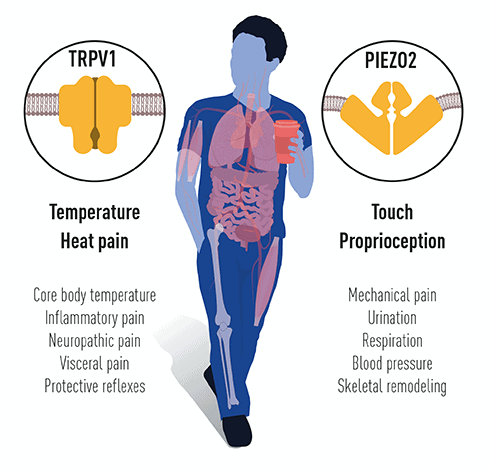On October 4, 2021, the Nobel Assembly at Karolinska Institutet jointly awarded David Julius and Ardem Patapoutian the Nobel Prize in Physiology or Medicine for their independent discoveries of receptors responsible for our ability to sense heat, cold, and touch (see PRF related interview with Julius and Patapoutian).
In the late 1990s, David Julius at the University of California, San Francisco, began to systematically interrogate individual proteins expressed by sensory neurons to assess which were capable of responding to capsaicin, the chemical irritant found in chili peppers. This experimentation identified a gene that encoded a novel ion channel protein which was later named TRPV1. Upon further investigation, it was discovered that the TRPV1 channel is sensitive to heat and opens at temperatures greater than 43°C. The resulting influx of ions through the open channel induces electrical signals in the nervous system that are perceived as painful.
Following the discovery of TRPV1, additional temperature-sensing receptors began to be elucidated. Independently of one another, Julius and Patapoutian carried out experiments using menthol and identified the ion channel TRPM8. While TRPV1 and TRPM8 are both members of the same superfamily, TRPM8 is primarily responsible for the sensation of cold temperatures.
During this time, Patapoutian, working at the Scripps Research Institute in La Jolla, California, sought to identify receptors activated by mechanical stimuli. Using a cell line that produced a measurable electrical signal when insulted with a micropipette, and a similar systematic approach as that of Julius, Patapoutian discovered an ion channel protein whose knockout rendered the cell line insensitive to physical insult. This mechanosensitive ion channel would be named Piezo1, and lead to the discovery of a second protein, named Piezo2, which also responded to mechanical pressure. Similar to the mechanism of the temperature-sensing receptors, both Piezo1 and Piezo2 open following the exertion of mechanical force to the membranes of sensitive cells, and the resulting influx of ions induce electrical signals in the nervous system.

The discoveries of both Julius and Patapoutian have impacted the fundamental understanding of how we sense and interact with our environment. Briefly, TRPV1 has been shown to play a role in how we regulate our core body temperature and respond to various types of pain, and Piezo2 is involved in how we regulate our blood pressure and breathing, to name a couple. These discoveries continue to inform the development of treatments for a variety of disease conditions, including chronic pain. The work of Julius and Patapoutian altered the trajectory of pain research, and they have been rewarded with the highest honor in their field.
Gregory Carbonetti, PhD, is the senior manager of the Pain Research Forum.
Further reading
The Nobel Prize in Physiology or Medicine 2021. NobelPrize.org. Nobel Prize Outreach AB 2021. Tue. 5 Oct 2021. Summary.
The Nobel Prize in Physiology or Medicine 2021. NobelPrize.org. Nobel Prize Outreach AB 2021. Tue. 5 Oct 2021. Press release.
Featured image: Nobel Prize Outreach. Illustrator: Niklas Elmehed
Inline image: The Nobel Committee for Physiology or Medicine. Illustrator: Mattias Karlén


